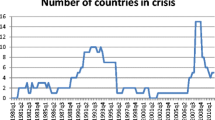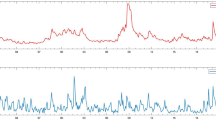Abstract
This paper proposes a novel financial stress index (FSI) of the Chinese economy that effectively identifies the recent major financial crises. Using the Chinese FSI, we analyze the international transmission between the financial stress in China and the US/euro area’s financial condition and stock market sentiment. We find that the Chinese FSI is informative in explaining the international spillover effects and the spillovers are stronger during crisis periods. While the international transmission of financial stress is mainly from US/euro area to China, the spillover effects during Chinese cash crunch and European sovereign debt crises particularly have the opposite direction of the international spillovers. Our evidence suggests that the spillovers from financial stress in China to euro area’s financial condition and stock market sentiment are attributed to their trade and financial linkages.
Access this chapter
Tax calculation will be finalised at checkout
Purchases are for personal use only
Similar content being viewed by others
Notes
- 1.
Financial stress is regarded as a state of financial instability, namely, the amount of materialized systemic risk in an economy [1].
- 2.
von Hagen et al. [35] and Chor and Manova [36] recognized the 2008 subprime crisis period from August 2007 to May 2009 and from August 2007 to October 2009, respectively. Albertazzi et al. [37] and Popov and van Horen [38] classified the periods from April 2010 to December 2011 and from July 2009 to December 2011 as the European sovereign debt crisis, respectively.
- 3.
For instance, Merryl Lynch announced a loss of 8.4 billion USD on 24 October 2007, and Bear Stearns was sold for 2 USD per share to JP Morgan Chase to avoid bankruptcy on 16 March 2008. The share price of Bear Stearns was 145.48 USD an year ago.
- 4.
The Federal Reserve Bank supplied 41 billion USD to banks at low interest rates on 1 November 2007, and this is the largest single bailout since the injection of 50 billion USD on 19 September 2011.
References
Holló, D., Kremer, M., Lo Duca, M.: CISS-a composite indicator of systemic stress in the financial system. In: European Central Bank Working Paper No. 1426 (2012)
Hakkio, C.S., Keeton, W.R.: Financial stress: what is it, how can it be measured, and why does it matter? In: Economic Review of Federal Reserve Bank of Kansas City Second Quarter 2009 (2009)
Kliesen, K. L., Smith, D. C.: Measuring financial market stress. Economic Synopses - Federal Reserve Bank of St. Louis No. 2 (2010)
Oet, M.V., Dooley, J.M., Ong, S.J.: The financial stress index: identification of systemic risk conditions. Risks 3(3), 420–444 (2015)
Illing, M., Liu, Y.: Measuring financial stress in a developed country: an application to Canada. J. Financ. Stabil. 2(3), 243–265 (2006)
Hanschel, E., Monnin, P.: Measuring and forecasting stress in the banking sector: evidence from Switzerland. In: Bank of International Settlement Working Paper No. 22 (2005)
Sensoy, A., Ozturk, K., Hacihasanoglu, E.: Constructing a financial fragility index for emerging countries. Financ. Res. Lett. 11(4), 410–419 (2014)
Grimaldi, M.: Detecting and interpreting financial stress in the euro area. In: European Central Bank Working Paper No. 1214 (2010)
Grimaldi, M.: Up for count? Central bank words and financial stress. In: Riksbank Research Paper Series No. 83 (2011)
Ji, G., Kim, D.S., Ahn, K.: Financial structure and systemic risk of banks: evidence from Chinese reform. Sustainability 11(13), 1–22 (2019)
Huang, X., Zhou, H., Zhu, H.: A framework for assessing the systemic risk of major financial institutions. J. Bank. Financ. 33(11), 2036–2049 (2009)
Balakrishnan, R., Danninger, S., Elekdag, S., Tytell, I.: The transmission of financial stress from advanced to emerging economies. Emerg. Mark. Financ. Trade 47(2), 40–68 (2011)
Park, C.Y., Mercado, R.V.: Determinants of financial stress in emerging market economies. J. Bank. Financ. 45, 199–224 (2014)
Hamao, Y., Masulis, R.W., Ng, V.: Correlations in price changes and volatility across international stock markets. Rev. Financ. Stud. 3(2), 281–307 (1990)
Dimpfl, T., Jung, R.C.: Financial market spillovers around the globe. Appl. Financ. Econ. 22(1), 45–57 (2012)
Apostolakis, G., Papadopoulos, A.P.: Financial stress spillovers in advanced economies. J. Int. Financ. Mark. Inst. Money 32, 128–149 (2014)
Jung, R.C., Maderitsch, R.: Structural breaks in volatility spillovers between international financial markets: contagion or mere interdependence? J. Bank. Financ. 47, 331–342 (2014)
Georgiadis, G.: Determinants of global spillovers from US monetary policy. J. Int. Money Financ. 67, 41–61 (2016)
Glick, R., Rose, A.K.: Contagion and trade: why are currency crises regional? J. Int. Money Financ. 18(4), 603–617 (1999)
Forbes, K.J., Chinn, M.D.: A decomposition of global linkages in financial markets over time. Rev. Econ. Statist. 86(3), 705–722 (2004)
Dovern, J., van Roye, B.: International transmission and business-cycle effects of financial stress. J. Financ. Stab. 13, 1–17 (2014)
Kollmann, R., Enders, Z., Müller, G.J.: Global banking and international business cycles. Eur. Econ. Rev. 55(3), 407–426 (2011)
Ehrmann, M., Fratzscher, M., Rigobon, R.: Stocks, bonds, money markets and exchange rates: measuring international financial transmission. J. Appl. Econom. 26(6), 948–974 (2011)
Dedola, L., Lombardo, G.: Financial frictions, financial integration and the international propagation of shocks. Econ. Policy 27(70), 319–359 (2012)
Cardarelli, R., Elekdag, S., Lall, S.: Financial stress and economic contractions. J. Financ. Stab. 7(2), 78–97 (2011)
Ahn, K., Dai, B., Kim, C., Tsomocos, D.P.: Measuring financial fragility in China. In: Saïd Business School Working Paper No. 2015-23 (2015)
Ahn, K., Lee, D., Sohn, S., Yang, B.: Stock market uncertainty and economic fundamentals: an entropy-based approach. Quant. Financ. 19(7), 1151–1163 (2019)
Louzis, D.P., Vouldis, A.T.: A methodology for constructing a financial systemic stress index: an application to Greece. Econ. Model. 29(4), 1228–1241 (2012)
Diebold, F.X., Yilmaz, K.: Measuring financial asset return and volatility spillovers with application to global equity markets. Econ. J. 119(534), 158–171 (2009)
Diebold, F.X., Yilmaz, K.: Better to give than to receive: predictive directional measurement of volatility spillovers. Int. J. Forecast. 28(1), 57–66 (2012)
Koop, G., Pesaran, M.H., Potter, S.M.: Impulse response analysis in nonlinear multivariate models. J. Econom. 74(1), 119–147 (1996)
Pesaran, H.H., Shin, Y.: Generalized impulse response analysis in linear multivariate models. Econ. Lett. 58(1), 17–29 (1998)
Simon, D.P., Wiggins, R.A.: S &P futures returns and contrary sentiment indicators. J. Futures Mark. 21(5), 447–462 (2001)
Bandopadhyaya, A., Jones, A.L.: Measures of investor sentiment: a comparative analysis put-call ratio vs. volatility index. J. Bus. Econ. Res. 6(8), 27–34 (2008)
von Hagen, J., Schuknecht, L., Wolswijk, G.: Government bond risk premiums in the EU revisited: the impact of the financial crisis. Eur. J. Polit. Econ. 27(1), 36–43 (2011)
Chor, D., Manova, K.: Off the cliff and back? Credit conditions and international trade during the global financial crisis. J. Int. Econ. 87(1), 117–133 (2012)
Albertazzi, U., Ropele, T., Sene, G., Signoretti, F.M.: The impact of the sovereign debt crisis on the activity of Italian banks. J. Bank. Financ. 46, 387–402 (2014)
Popov, A., van Horen, N.: Exporting sovereign stress: evidence from syndicated bank lending during the euro area sovereign debt crisis. Rev. Financ. 19(5), 1825–1866 (2015)
Jang, H., Song, Y., Sohn, S., Ahn, K.: Real estate soars and financial crises: recent stories. Sustainability 10(12), 4559 (2018)
Zhou, X., Zhang, W., Zhang, J.: Volatility spillovers between the Chinese and world equity markets. Pac. Basin Financ. J. 20(2), 247–270 (2012)
Author information
Authors and Affiliations
Corresponding author
Editor information
Editors and Affiliations
Rights and permissions
Copyright information
© 2023 The Author(s), under exclusive license to Springer Nature Switzerland AG
About this paper
Cite this paper
Ji, G., Cong, L., Kim, J., Ahn, K. (2023). Financial Stress in China and International Spillover. In: Arai, K. (eds) Intelligent Systems and Applications. IntelliSys 2022. Lecture Notes in Networks and Systems, vol 543. Springer, Cham. https://doi.org/10.1007/978-3-031-16078-3_19
Download citation
DOI: https://doi.org/10.1007/978-3-031-16078-3_19
Published:
Publisher Name: Springer, Cham
Print ISBN: 978-3-031-16077-6
Online ISBN: 978-3-031-16078-3
eBook Packages: Intelligent Technologies and RoboticsIntelligent Technologies and Robotics (R0)




